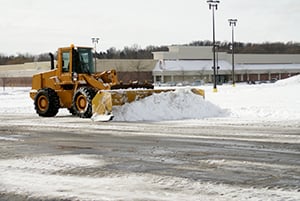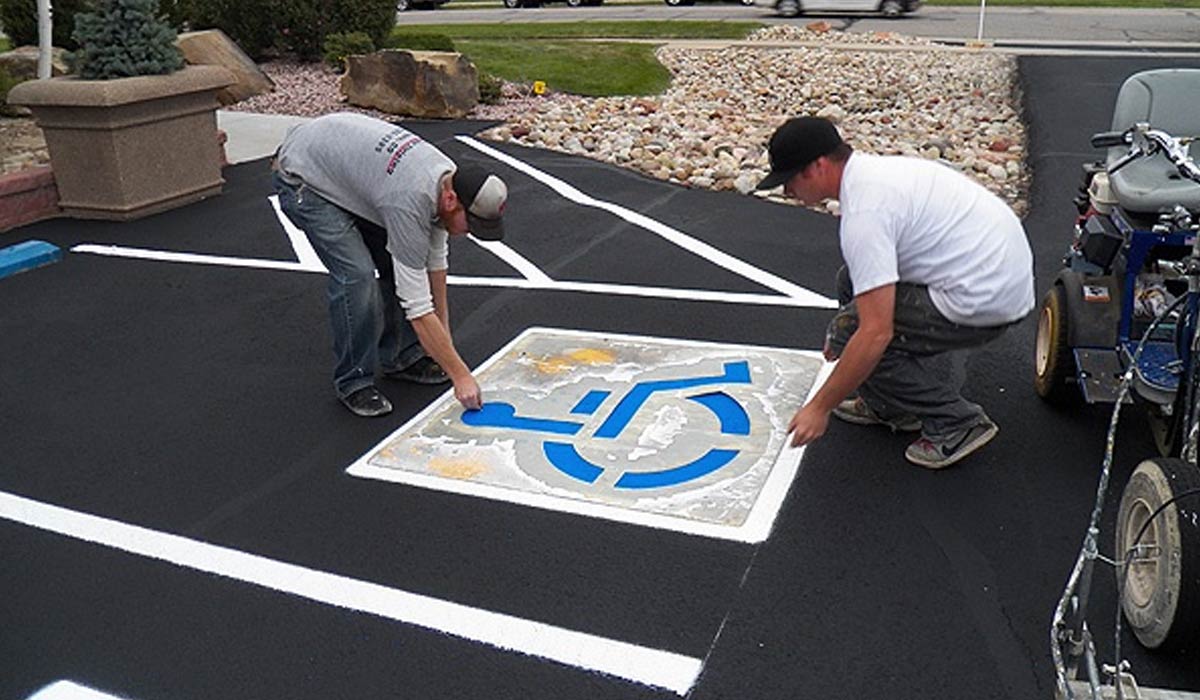How to paint a parking lot requires using special paints created for use on asphalt and concrete. Asphalt is a specialized type of concrete that utilizes a petroleum-based binder. So, it is critical to have the right type of paint that adheres to asphalt and doesn't wash away.
Table of Contents
Which Parking Lot Paint to Use
Is it Okay to Use Standard Paints for Parking Lot Line Painting?
Standard paints (such as the ones we use at home) will not adhere to either asphalt or concrete properly. Some types of paints, such as latex and acrylic, will peel off the surfaces in a very short time, meaning you shouldn’t use them for painting parking lots.
FREE DOWNLOAD!

Get Your FREE Printable Cheatsheet
Not only will they never adhere entirely to the surface. They will form bubbles underneath, and you can practically push painted parking spots off the pavement
The result is so poor that you would have been better off painting parking lot lines with chalk. That’s why it is absolutely essential to have traffic paint – the right traffic paint.
How to Paint a Parking Lot: Types of Paint
Special asphalt and concrete paints are specifically formulated to adhere to such pavements. Paint for parking lot lines may be a) water-based or b) solvent-based.
Solvent-based traffic paints are sometimes referred to as alkyd. The term, though, is not particularly accurate since alkyd is merely one of the ingredients used as a binder.
Video: How to choose the best parking lot paint
Shop Line Striping Paint and Stencils
Water-based parking lot paints are considered more environmentally friendly. This is because most solvents used in solvent-based paints emit volatile organic compounds (VOCs) that are bad for the environment and the health of others. Because of this, it is best not to use solvent-based paints in warehouses or other indoor facilities.
The fumes can cause headaches and have been indicated as a cause of what is called “sick building syndrome.” Even after the paint has dried, the fumes linger on for days or even longer, especially if the building is well-insulated and the fresh air exchange is limited.
It is also of the utmost importance to check your local laws when choosing paint for painting parking lots. Many states have banned solvent-based products entirely. In this case, there is no need to second-guess what type to use. Water-based will be what you use exclusively as you learn how to paint a parking lot.
You can paint parking lot areas that are outdoors or in covered spaces with either solvent-based or water-based paints. Keep in mind that solvent-based paints are a little bit pricier. The good news, though, is that it is more durable.
We recommend solvent-based paints for high-traffic areas, such as roadways, airport runways, and racetracks.
Related: Best Kind of Pavement Paint for Long-Lasting Parking Lot Lines
How to Price a Linestriping Job Profitably
- How to price your first striping job with zero guesswork
- Which equipment to buy—and how to use and maintain it
- Spot high-profit jobs and skip costly mistakes
- When to charge more and how to quote with confidence
- Work faster and boost profit margins
Which Traffic Paint Is Right For Painting Parking Lots?
You might think of water-based paints as best for general purposes or as your only option where local laws specify. If you want to paint parking lot areas surrounding a small business or a shopping center, the water-based paints will work just fine, as long as you choose one formulated for asphalt and concrete.
Even mall owners with heavy traffic often choose water-based simply because they dry faster. That way, the parking area is closed to traffic for as short a time as possible.
Shop Line Striping Paint and Stencils
Other Paints Used For Parking Lot Line Painting
Chlorinated Rubber Paint
For painting parking lot curbs, posts, and similar items typically found in larger lots, chlorinated rubber paints are sometimes chosen.
These paints dry to a rubbery texture. They are resistant to chipping and may be the most durable. The expense, however, makes them a less popular choice for painting parking lot lines and stripes.
Thermoplastic Paints
Thermoplastic paint is another option to think about for how to paint a parking lot. As the name suggests, these paints contain plastic polymers, making them more durable. Keep in mind, though, that this option is more expensive than other ones used for painting parking lots.
There is much to consider when you paint parking lot areas. The bottom line is that you want to choose something as durable as possible while also being affordable and meeting your local law requirements.
How to Paint a Parking Lot
Getting the right gear to paint a parking lot is easier once you are familiar with the steps. Forgetting just one item will wreak havoc with your plans! Imagine going through the process of clearing a parking lot twice because you forgot to get enough paint. So, let’s go through a quick rundown of what you’ll need.

Line Stripe Paint
Here’s a simple parking lot paint calculator where you can easily enter the number of linear or square feet you’ll be striping. Remember, you’ll need to do this for each color you are using (in other words, don’t forget blue for the handicap spaces).
Use white or yellow paint to paint parking zones. As mentioned, use blue paint to mark handicap spots. Use red traffic paint to mark fire zones.
You’ll also need to decide on whether you want to use water or oil-based parking lot paint. Be sure to check local regulations and laws, as some areas prohibit the use of solvent-based paint.
A Way To Apply The Paint
If you're new to line striping, then feel free to use a roller. However, this can be tedious if you're painting large parking lots.
Line stripers (also known as line striping machines) make the job far easier, and there’s the right size of equipment for every need. How do you paint a parking lot with equipment that doesn’t have to break the bank either?
Once you determine the best way to apply the paint for your needs, you’ll know whether you need pails or cans of aerosol paint.

Stencils
To paint parking lots, you definitely have to have stencils. At the very least, you’ll need to mark the handicap stalls.
You may also need numbers to assign stalls or letter stencils. And don’t forget about the word stencils - like Fire Lane and No Parking, and roadway stencils when painting parking lots.
Grit
If you’ve ever watched an auto race on a street circuit in the rain, you already know the painted lines are where the cars slip and lose grip.
Humans slip on painted parking spots and roads, too, so it is essential to use grit, especially in places like the diagonal lines of a pedestrian crosswalk.
When painting parking lots, paint your surface, apply grit, and then paint again for maximum adhesion.
High-Visibility Glass Beads
High-visibility glass beads also need to be applied when the paint is still wet. These beads greatly increase the visibility of the painted parking spots and are very reflective.
The only downside to them is that the snow plows are hard on them, and they need to be redone more often.
Final Pieces Of Gear For Painting Parking Lots
I know it seems obvious, but we often overlook the obvious! Here are the essential items needed for the blocking-off aspect of how to paint a parking lot.
- Traffic cones
- Pylons
- Caution tape
- Sawhorses
Finally, have sealcoat on hand to cover up any paint spills or mistakes.
Jobs like this are time-sensitive; you want to get your parking stalls back in use as fast as possible. Make your list and get enough paint in all the colors you need and in the right type (can or pail). Figure out how you’re going to apply the paint. Get your stencils and the grit or glass beads ready if you’ve decided to use them. Work out how you’ll block access to your parking area. There you are, a complete overview of how to paint a parking lot.
Snow Removal Causes Pavement Paint Damage
 Spring thaw is a great time of year, especially because it reveals the state of our parking lots and pavement paint after snow removal. Now is the best time to spring into action, get your parking lot paint, and take care of the ravages of winter.
Spring thaw is a great time of year, especially because it reveals the state of our parking lots and pavement paint after snow removal. Now is the best time to spring into action, get your parking lot paint, and take care of the ravages of winter.
Clear It To See It
First and foremost, get out the gas blower and/or power washer to completely clear the asphalt. There’s always a chance the sand and salt have covered everything.
Once the asphalt is clean and the painted parking spots are revealed, you’ll be able to see if the plows scraped off more than just snow!
Look for:
- Cracks that need filling
- The presence of fresh asphalt sealer
- Clear and bright pavement paint
Remember: Crack filling comes first, then sealcoating, then painting parking lots!
Check Your Parking Lot Painting Equipment and Supplies
If you’re learning how to paint parking lots for the first time, our free line striping course is an invaluable resource you can use.
Make sure all your line striping equipment, including spray guns and tips, is in good working order. Check to see that all stencils are in good shape and that you have enough of each type.
Ensure you have enough caution tape and pylons to block traffic from your work area.
Use our calculator to easily figure out how much pavement paint you’ll need to order. Remember to do this for each color.
Write a list as you go to include what you need to purchase (e.g., replacement tips, parts, new equipment, parking lot paint, stencils, etc.) before painting parking lots.
Video: Line Striping Equipment & Supplies
With all this in place, you’re ready to spring into action as soon as the weather is dry and outdoor temps reach over 50°F.
Need a cheat sheet on when to apply traffic paint? Our downloadable Application Temperature Cheatsheet tells you the lowest and highest temperatures for applying a sealer, asphalt repairs, and parking lot paints.
Spring cleaning your lot and checking the condition of the asphalt and your supplies will have you set to get out there with your pavement paint and repair the winter damage by painting parking lots.
How to Maintain Painted Parking Spots
Proper maintenance is the key to prolonging the lifespan of parking lot paint. Here are some things you can do to ensure those lines and stenciled spots last longer.
Use the Right Kind of Parking Lot Paint
Generally, oil-based paints are more durable than water-based paints. However, the downside is that oil-based paints are more susceptible to cracking because they form a harder coat when they dry. This coat becomes more rigid and less flexible over time, resulting in brittle paint that easily cracks and chips.
However, the good news is that paint manufacturers have been improving the formula of water-based paints over the years so that their resistance to wear and tear is almost on par with that of oil-based paints.
Don't Skimp on Paint for Parking Lot Lines
In many cases, the more expensive the material is, the better its quality. So don't waste your money on cheap paint that chips off easily after painting parking lots. Instead, invest in the best traffic paint you can find and watch those lines and stenciled spots last for many years.
Don't Skip the Surface Prep
Whether you're painting a parking lot or sealcoating asphalt, surface prep is a crucial part of pavement maintenance. Never skip surface preparation before starting line striping, as the last thing you want is for the paint to adhere to dust, debris, and leaves instead of the asphalt.
Apply Crack Filling and Sealcoat
Fill cracks and apply sealcoat on asphalt before you start line striping so as not to waste precious paint.
Suggested Reading
Asphalt Kingdom has a huge selection of how-tos and informative articles for all things asphalt. Here are some suggested follow-up pages:
- Asphalt Supply Calculators — Free calculators to find out how much product you need to paint a parking lot, as well as for sealant and crack filler.
- Property Owner’s Asphalt Maintenance Course — This course will show you exactly how to maintain your parking area yourself. Thorough, simple, and free.
- Asphalt Maintenance: Towns Choose Asphalt Kingdom — See how towns made use of Asphalt Kingdom’s know-how to do their own maintenance.
- Pavement Paint: What Kind Do You Need For Long Lasting Parking Lot Lines?
Includes aerosol as well as water and solvent-based comparisons, but also includes important how-to tips for the best way to apply.
WWant to learn more about the right way to paint parking lot areas or what type of traffic paint you should use? Or maybe you're wondering whether it's time to invest in new line striping equipment. Contact us today by calling 1-866-399-5562 or sending a message to sales@asphaltkingdom.com.
FREE DOWNLOAD!










